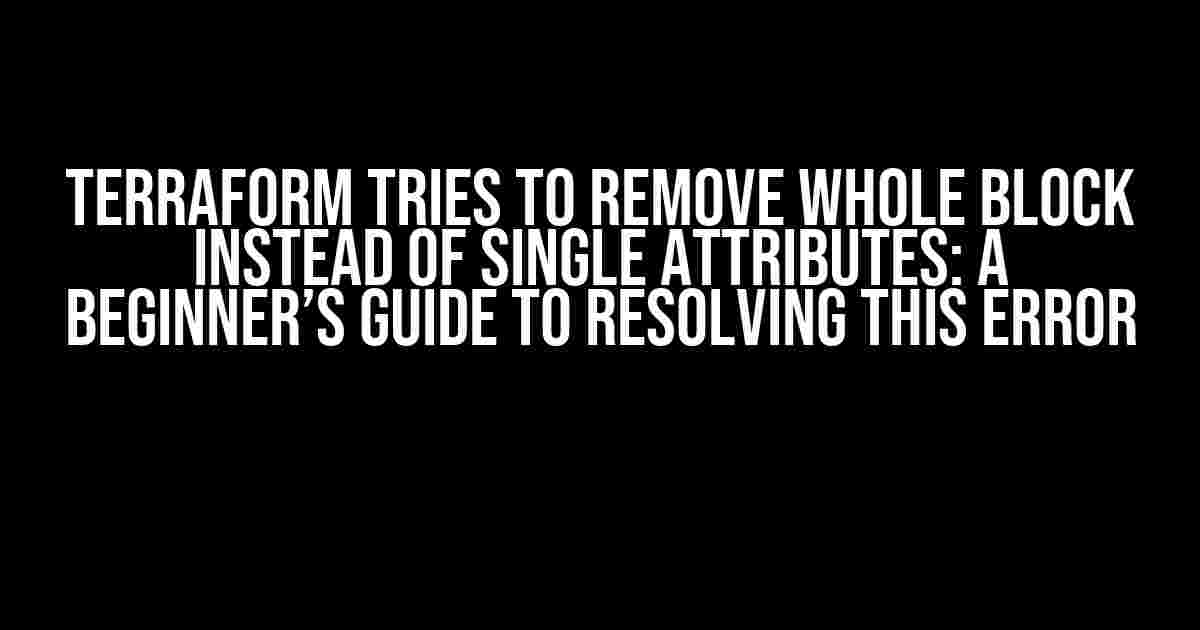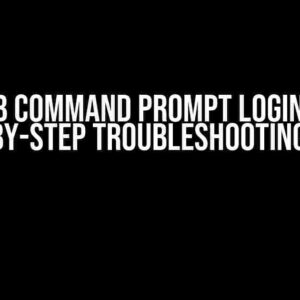If you’re reading this article, chances are you’ve stumbled upon a frustrating issue with Terraform: it’s trying to remove an entire block of code instead of just a single attribute. Don’t worry, you’re not alone! This error can be perplexing, especially for beginners. Fear not, dear reader, for we’re about to embark on a journey to resolve this issue and regain control over your Terraform configurations.
What causes Terraform to remove whole blocks?
Before we dive into the solution, let’s understand why Terraform behaves this way. The culprit behind this error is often related to how Terraform manages state and resources. When you make changes to your configuration files, Terraform computes the differences between the current state and the desired state. If it detects a significant change, it might decide to remove the entire block instead of just updating the attribute.
This can occur due to various reasons, such as:
- Incorrect resource syntax or indentation
- Changes to resource types or properties
- Missing or incorrect dependencies
- External factors, like changes to the underlying infrastructure
Understanding Terraform’s Resource Management
To effectively troubleshoot this issue, it’s essential to grasp how Terraform manages resources. Terraform uses a concept called the “resource graph” to track dependencies between resources. The resource graph is a data structure that represents the relationships between resources, including dependencies, dependencies, and ordering constraints.
+---------------+
| Resource A |
+---------------+
|
|
v
+---------------+
| Resource B |
+---------------+
|
|
v
+---------------+
| Resource C |
+---------------+
In this example, Resource A depends on Resource B, which in turn depends on Resource C. When you make changes to Resource A, Terraform will recomputed the resource graph and determine the necessary actions to take.
Resolving the Error: Step-by-Step Guide
Now that we’ve covered the basics, let’s get down to business! Follow these steps to resolve the error and regain control over your Terraform configurations:
-
Review your Terraform configuration files
Check your Terraform configuration files (.tf files) for any syntax errors, incorrect indentation, or missing dependencies. Make sure to inspect the resource blocks and attributes carefully.
terraform validateRun the
terraform validatecommand to check for any syntax errors or issues with your configuration files. -
Check the Terraform state file
Terraform stores its state in a file called
terraform.tfstate. Inspect this file to see if there are any inconsistencies or errors.{ "version": 4, "terraform_version": "0.14.0", "serial": 1, "lineage": "1234567890abcdef", "outputs": {}, "resources": [], "dependencies": [] }If you find any errors or inconsistencies, you can try to manually edit the state file or recreate it from scratch.
-
Use the -target option
The
-targetoption allows you to specify a specific resource or module to update. This can help Terraform focus on the specific attribute you want to change instead of removing the entire block.terraform apply -target=resourcetype.nameReplace
resourcetype.namewith the actual resource type and name you want to update. -
Use the -replace option
The
-replaceoption tells Terraform to replace the entire resource instead of updating individual attributes. Be cautious when using this option, as it can lead to unintended consequences.terraform apply -replace=resourcetype.nameUse this option sparingly and only when you’re certain you want to replace the entire resource.
-
Check for external factors
Verify that there are no external factors affecting your Terraform configuration, such as changes to the underlying infrastructure or dependencies.
External Factor Description Infrastructure changes Check if there have been any changes to the underlying infrastructure, such as updates to the cloud provider or network configurations. Dependency issues Verify that all dependencies are correctly configured and up-to-date. -
Revert to a previous state (if necessary)
If all else fails, you can try reverting to a previous state using the
terraform statecommand.terraform state showThis command will display the current state of your Terraform configuration. You can then use the
terraform state pullcommand to retrieve a previous state.terraform state pull <STATE_NUMBER>Replace
<STATE_NUMBER>with the actual state number you want to revert to.
Conclusion
Terraform’s tendency to remove entire blocks instead of single attributes can be frustrating, but with the right approach, you can overcome this error. By following the steps outlined in this article, you’ll be well-equipped to troubleshoot and resolve this issue. Remember to carefully review your Terraform configuration files, check the state file, and use the -target and -replace options judiciously. With practice and patience, you’ll become a Terraform master, effortlessly managing your infrastructure as code!
If you have any further questions or concerns, please don’t hesitate to reach out. Happy Terraforming!
Additional Resources
For more information on Terraform and resource management, check out the following resources:
By understanding the inner workings of Terraform and following best practices, you’ll be able to overcome common errors and create robust, scalable infrastructure as code.
Frequently Asked Question
Terraform is an amazing tool, but sometimes it can drive you crazy! Don’t worry, we’ve got you covered. Here are some FAQs to help you troubleshoot that pesky Terraform behavior.
Why does Terraform want to remove the whole block instead of just the single attribute I changed?
This might be due to Terraform’s default behavior of managing the entire block as a single unit. When you modify an attribute, Terraform assumes you want to update the entire block, not just the single attribute. To avoid this, you can use the `ignore_changes` meta-argument to specify which attributes Terraform should ignore when detecting changes.
How can I prevent Terraform from removing the entire block when I update a single attribute?
You can use the `Lifecycle` meta-argument to customize Terraform’s behavior. Set `ignore_changes` to `all` to tell Terraform to ignore changes to the entire block. Alternatively, you can specify the specific attributes you want Terraform to ignore using the `ignore_changes` attribute.
What’s the difference between `ignore_changes` and `ignore_changes.all`?
`ignore_changes` allows you to specify a list of attributes to ignore, whereas `ignore_changes.all` tells Terraform to ignore changes to all attributes within the block. Be careful when using `ignore_changes.all`, as it can lead to unintended consequences if not used correctly!
Can I use `ignore_changes` with nested blocks?
Yes, you can! Terraform supports using `ignore_changes` with nested blocks. Just be aware that Terraform will recursively apply the `ignore_changes` meta-argument to all nested blocks. Make sure to test your configuration carefully to avoid unexpected behavior.
Is there a way to debug why Terraform is trying to remove the whole block?
Yes! Enable Terraform’s debug logging by setting the `TF_LOG` environment variable to `DEBUG`. This will give you detailed insights into Terraform’s decision-making process, helping you identify the root cause of the issue.



